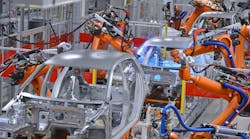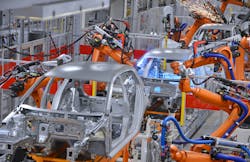AI Software that Monitors Clamp Performance Earns Award
Festo has been named an artificial intelligence (AI) champion for the company’s project Intelligent Pneumatic Runtime Monitoring at the inaugural Baden-Württemberg awards ceremony. (Baden-Württemberg is one of Germany’s leading regions for AI development.)
The AI-based software was developed for an auto company that was experiencing too many failures with the pneumatic clamps used to hold body parts together while being welded. Previous policy was to replace the clamps only when they broke.
When one did break, the machines stops while well-trained maintenance personnel spend 30 to 60 minutes replacing the part and restarting production. If the broken clamp is on the main assembly line, the shutdown can cost several hundred thousand dollars. Even if the broken clamp is on a side assembly line, costs are substantial, especially compared to the cost of the clamp. With more than 100,000 clamps in a single plant, the company suffered 350 to 400 broken clamps annually at a cost of at least 200 hours of downtime.
The company did use PLCs to monitor the time it took for the two pneumatic cylinders on the clamps to reach the end of their strokes (end position to end position). If it took longer than one second, it triggered an alarm, alerting a technician to take a look at the clamp.
”Too often, however, the strokes triggered the alarm threshold randomly due to temporary internal leaks between the clamp’s two-cylinder chambers, and then the error would disappear,” says Dominic Kraus, product manager of Digital Business at Festo. “However, the clamp would soon fail. In other cases, the clamps react too slowly to the valve switching due to internal friction, and this is not monitored by the PLCs.
“And in several cases,” Kraus added, “the clamps moved too fast because of a broken internal needle bearing, and this error wouldn’t be detected at all. But it would prevent the clamp from exerting the necessary force which causes faulty welds.”
The auto company was familiar with AI, and its engineering team felt AI might be a solution, but they lacked the pneumatic expertise to apply it in this application. They decided to work with Festo, a leading pneumatics company. Festo brought in data scientists from Resolto, a firm in the Festo Group that specializes in AI development.
Festo started by accumulating offline clamp data to show the customer the benefits of AI and predictive maintenance before adding any software to the system. The AI software was written in Docker, an open-source tool that simplifies creating and deploying applications. Docker runs on any Linux machine. This let the auto company install the software on an edge computer or an IPC. The auto company can also scale the program to work on a local server or in cloud environments, depending on its needs.
The software’s inputs are the signals from the two limit switches in each clamp. From this and historical data, the AI calculates a health score for the clamp. The AI also calculated feature relevance—i.e., how much influence each sensor signal had on any anomalous event. The relevance was then used to classify the probable cause of the anomaly. Doing this with traditional PLC programming would take too much effort because every case needs to be known in advance and the program would have to be changes for any new types of detected error. Plus, each clamp threshold would need to be set up individually by the programmer, which would take considerable time for 100,000 clamps. Further adding to the lost time, the setup would need to be redone after replacing a clamp.
With AI, the individual pattern of each clamp is determined. Different errors cause different changes in the data pattern, and the AI can detect and classify them. This lets the finished AI application detect that something is wrong, pinpoint the cause for operations and recommend actions. For instance, the software would “know” an increase in internal friction is not as urgent as a broken needle bearing. In the first case, the company can continue using the clamp to make good welds, but production might slow somewhat prior to scheduled maintenance. In the latter case, the company would replace the clamp at the first opportunity and check the welds made while the clamp was faulty. Both responses would be more beneficial than an unplanned shutdown.

